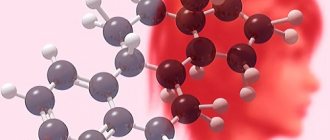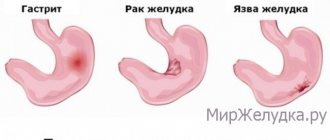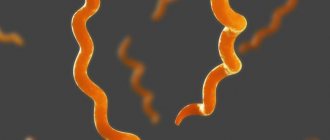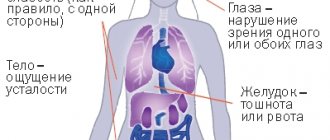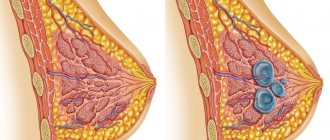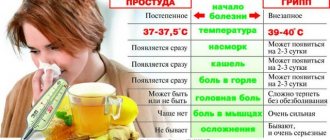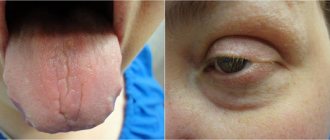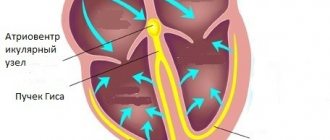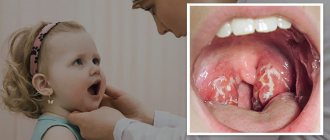The cold is a common ailment, especially during the cold season. It can occur in both adults and children. The symptoms of a cold infection are similar to those of the flu, sore throat and other infections, however, they are more mildly expressed. It is necessary to treat a cold as soon as its first signs appear, otherwise an initially harmless infection can turn into a serious complication.
In this article we will look at the features of treating colds in children and adults when their first symptoms appear.
First symptoms of a cold
What are the characteristic features of a cold?
According to medical statistics, almost 90% of all people - both big and small - know from their own experience what a cold infection is. Moreover, the disease is so common, and it does not surprise anyone that many people in winter perceive cold symptoms as inevitable; rarely does anyone consult a doctor about this.
But some still have to visit the clinic. This happens when a cold has developed into a more serious complication.
Cold viruses enter the body through airborne droplets. In addition, they can also leak through direct physical contact - through kissing, sharing utensils, etc.
Signs
How does the disease manifest itself? The throat turns red, swells, it feels sore, and sometimes painful. Feeling of chills, limbs become cold. This is a clear sign of the onset of infection.
There is a general feeling of weakness in the body, sometimes aches in the joints and pain in the muscles, a feeling that they are “pulled.” Apathy and lethargy are also signs of an onset of a cold.
Makes me sleepy. With such symptoms, it is very difficult to concentrate on work, sometimes it is simply impossible. The best way out for such symptoms is to take time off from work and go home for treatment. Otherwise, you can not only suffer yourself, but also infect half of the team.
Your head may also hurt. A characteristic sign that a cold is starting is the feeling that something is tickling in the nose. This indicates that the infection has entered the body. It's time to take action.
Temperature
Let's talk about the “relationship” between colds and fever.
Many people believe that a cold must be accompanied by a high temperature. However, this is not a required feature. The temperature will appear only when the viruses are already starting to attack quite strongly. And at the very beginning of the disease there may still be no temperature. However, already at this stage it is necessary to begin the fight so that the fever does not arise in principle.
Colds without fever at the very beginning are more common in adults. As for children, this is not typical for them. A child’s body is more vulnerable, but at the same time it has better adaptability, so it immediately reacts violently to the introduction of an infection. This is manifested, among other things, by a rise in temperature.
Therefore, it is difficult to miss a child’s cold and not pay attention to it.
Conditions for successful therapy
For therapy to be successful, the following medical recommendations must be followed.
It is difficult to maintain health without a strong immune system. In order to protect it, you need to review your menu and choose foods rich in vitamins and nutrients. Nutrition plays a huge role in increasing the body's defenses. You need to change your diet to include more fruits and vegetables. Due to the presence of fiber, they will help improve intestinal function. This will help to quickly remove metabolic products that contain many harmful substances. In addition, fiber supplies the body with essential microelements.
To cure a lingering cold, you need to get proper rest. You must get enough sleep. The norm for a healthy adult is seven hours. The patient should rest 2-3 hours more, depending on the condition.
A restful sleep gives strength, restores organ function and promotes health. At this time, the medications you take are more effective. Before going to bed, you need to ventilate the room, as cool air cleanses the lungs and promotes better rest.
Requires drinking plenty of fluids. This must be clean water. In case of high temperature, it will prevent dangerous dehydration. Toxins, and with them pathogenic microorganisms, will dissolve in water and be excreted in urine or sweat. You cannot replace clean water with juices that come in packages or sugary drinks. You can drink herbal teas and berry fruit drinks.
A lingering cold also requires compliance with hygiene rules. It is necessary to wash your hands with soap more often, because a large number of pathogenic microorganisms settle on them, which remain viable for a long time. Upon contact with the patient’s face, the patient re-infects himself, delaying the treatment process.
More about medications
Let's take a closer look at the healing effects of the above medications.
Ergoferon
This drug perfectly and quickly eliminates irritation of the throat mucosa, due to which swelling subsides and redness goes away. Accordingly, painful and unpleasant sensations subside.
ergoferon tablets
Arbidol
This drug has an effective positive effect on the destruction of viruses. Arbidol is especially popular due to its effectiveness and at the same time safety. You can get rid of the first symptoms of a cold by morning by taking a tablet or two of this drug in the evening.
arbidol in capsules
Ingavirin
A modern antiviral drug. The active components of Ingavirin penetrate the virus cells, stopping their spread. That is why the drug quickly stops the infection. It is especially effective if taken immediately at the first sign of a cold without delay.
Ingavirin for the treatment of flu and colds
This medicine is very convenient to use: to relieve the first symptoms of a cold, it is enough to take just one capsule, regardless of meals.
This article will help you understand why a dry cough occurs without signs of a cold, and how you can quickly get rid of this problem.
This article will help you understand how to prepare a cold medicine recipe using ginger, honey and lemon.
what to do when your voice goes down after a cold, and what medications are best to use in this case, is described in great detail in this article: https://prolor.ru/g/lechenie/kak-vosstanovit-golos-posle-prostudy.html
Maybe
At the first sign of cough
A cough occurs when the receptors in the respiratory mucosa of the pharynx, larynx, trachea and bronchi are irritated.
One of the first symptoms of a viral infection is a dry cough. If after several days the dry cough turns into a wet cough with sputum, then most likely a bacterial infection has occurred. This is extremely important to know, because in case of a viral infection, antibiotics are contraindicated; in some cases (if a cough is not the only symptom, but is accompanied by a runny nose against a background of elevated body temperature), antiviral drugs may be prescribed; we will discuss them below.
The appearance of hoarseness in the voice and the so-called “barking cough” indicates the localization of the process in the larynx. Children prone to false croup and a barking cough require antihistamines (suprastin, loratadine, Zyrtec, etc.)
Dry cough
For dry coughs, antitussive drugs are quite effective, especially Sinekod. This drug is contraindicated for wet coughs, since when it is used, sputum will remain in the bronchi and complications cannot be avoided.
An effective folk remedy for treating dry cough is a decoction of viburnum berries. To prepare a decoction, you need to grind two tablespoons of berries to a paste, pour one glass of boiling water and heat in a water bath for 15 minutes, strain, cool, and add to 200 ml. boiled chilled water and take 1/3 cup 3-4 times a day. Also, dry cough is relieved by plantain syrup.
For dry cough, inhalation of saline solution (sodium chloride solution) using a nebulizer is effective.
Moist cough
For a wet cough, it is advisable to use expectorants and those that thin the mucus (for example, Ambroxol (Lazolvan)) both orally and by inhalation.
If the cough has become wet, then you should not self-medicate; it is better to consult a doctor who, by auscultation, will determine the presence of wheezing and decide on the need for antibiotic therapy.
For wet coughs, it is advisable to use expectorant herbs (chest collection). Elecampane, marshmallow, thermopsis, plantain, and thyme have an expectorant effect.
If you have a sore throat, you need to gargle with antiseptic solutions (for example, furatsilin, chlorhexidine, hexoral for gargling), herbal decoctions (St. John's wort, chamomile, calendula, sage) and irrigate with strepsil plus, hexoral, ingalipt, etc. sprays.
Colds in children
Let's consider the features of the symptoms and treatment of colds in children.
In children at the onset of a cold infection, the characteristic symptoms are the following:
- Cough, sometimes quite severe.
- A runny nose, which also causes a lot of trouble for children and parents.
- A child's cold differs from an adult cold in that in this case the temperature rises immediately, often being quite high.
It is precisely because the temperature rises immediately that it can be difficult to distinguish a childhood cold from the flu or another infection - viral or bacterial. Therefore, if a child becomes ill, it is always recommended to call a doctor, otherwise amateur treatment may go in the wrong direction. Let's say you give your baby antiviral drugs when he actually has a bacterial infection and requires antibiotics.
Children's colds are characterized by pronounced symptoms that arise sharply and immediately. In the morning, your child can safely go to kindergarten in full health, and by the evening you will pick him up from there with a fever.
As with the treatment of adult colds, children are also initially given antiviral drugs. Antiviral immunomodulators like Anaferon will be better suited for the child and will have a milder effect.
The fact that colds in children develop so sharply requires tireless monitoring of the baby’s condition. The temperature can rise even higher if it is not reduced, and in the case of a bacterial infection, complications can include serious ear infections, pneumonia, or sinusitis.
Video treatment of the first signs of a cold:
If the antiviral drug does not improve the condition, antibiotic treatment should be started with the permission of the doctor. Flemoxin, Augmentin, Amoxicillin or similar products are suitable.
Maybe
A persistent cold is a matter of diagnosis
A prolonged cold greatly increases the harm caused by normal symptoms. If, for example, your cough lasts more than three weeks, it may be viral in nature and go away spontaneously over the next month, or it may be regarded as chronic. In this case, it is advisable to do an x-ray or computed tomography scan of the paranasal sinuses. The optimal approach, provided normal radiographs are available, is to treat each suspected cause of cough sequentially, with the diagnosis based on the effectiveness of therapy. Of course, all this should be done by a doctor during a face-to-face consultation. If a high temperature lasts for an unusually long time, this may indicate some kind of inflammation in your body, such as tonsillitis or adnexitis. In other words, a prolonged cold is a serious reason to consult a doctor. In this case, it is unlikely to be prudent to turn to traditional medicine and grandmother’s advice. Because the most important emphasis in treating a persistent cold is diagnosis.
A sluggish, prolonged cold is a very unpleasant phenomenon. Most often, we get colds in the autumn-spring period, when it is easiest to catch an infection. As a rule, with adequate treatment, cold symptoms disappear within a week. But it happens that the disease becomes protracted and literally exhausts the patient. Let's figure out why a cold doesn't go away for a month or more, and what to do in such a situation.
What is a cold and how does it develop?
The autumn-winter period is the cold season. Almost every person gets a cold in one season, and people with reduced immunity can get sick several times a year. Many people believe that colds occur only against the background of hypothermia, but the disease is caused by pathogenic microorganisms - viruses or fungi, which rapidly multiply against the background of reduced immunity.
Types of colds:
- Acute respiratory infections are respiratory diseases caused by viruses, bacteria or fungi.
- ARVIs are infections caused only by viruses.
The cold is considered the most common upper respiratory disease. Statistics show that children who attend kindergartens and schools get colds more often. It’s rare that a parent leaves a child with a runny nose at home and takes him to kindergarten, where the cold spreads among the group. As a result, the child, due to the lack of bed rest and necessary treatment, becomes even more ill, often with complications from the bronchopulmonary system.
Do I need to take antiviral drugs for a cold?
Any antiviral medicine gives results only when taken at the initial stage of the disease.
It gives the immune system time to “swing up” and begin an independent fight against the infectious process, inhibiting its pathogens by supplying interferons and other similar substances to the site of inflammation.
Therefore, it should be noted that their effectiveness is maximum in the first days of the disease.
Then you can even stop taking them, since the body already independently produces the required number of protective cells and compounds that kill pathogenic microflora.
to the content?
Symptoms of colds
During a cold, the human body is exposed to toxins produced as a result of fighting viruses. The need to remove them leads to intensive production of mucous secretions.
In this case, the regulation of fluid by the glands is disrupted, since they do not have time to perform a large amount of work. Mucus stagnation forms in the sinuses. In addition, the following signs of a cold in adults are observed:
- weakening of the body;
- feeling unwell;
- feeling of aching muscles and joints;
- headache;
- increase in body temperature;
- disturbance of heat exchange (sweating, chills);
- poor sleep and appetite;
- inflammation of the lymph nodes;
- discomfort in the throat (pain, soreness);
- appearance of cough;
- visual discomfort (lacrimation, eye pain).
Cold symptoms in adults subside on the 3rd day. There is an improvement in the patient's well-being. In most cases, complete recovery occurs within a week after the onset of the disease. The duration of the disease depends on the state of the immune system and how the cold was treated.


